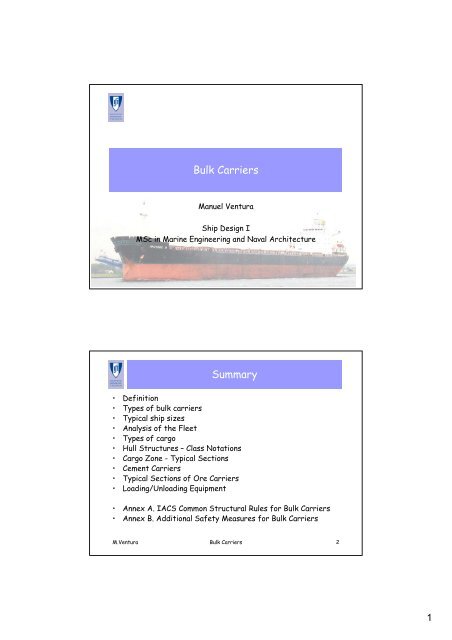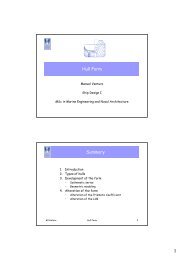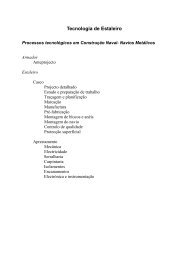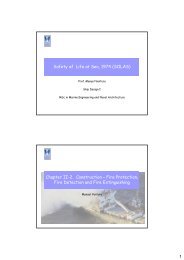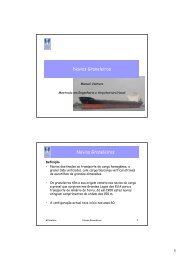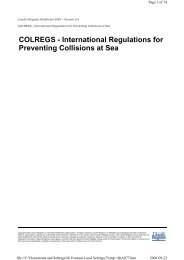Bulk Carriers Summary
Bulk Carriers Summary
Bulk Carriers Summary
Create successful ePaper yourself
Turn your PDF publications into a flip-book with our unique Google optimized e-Paper software.
<strong>Bulk</strong> <strong>Carriers</strong><br />
Manuel Ventura<br />
Ship Design I<br />
MSc in Marine Engineering and Naval Architecture<br />
<strong>Summary</strong><br />
• Definition<br />
• Types of bulk carriers<br />
• Typical ship sizes<br />
• Analysis of the Fleet<br />
• Types of cargo<br />
• Hull Structures – Class Notations<br />
• Cargo Zone - Typical Sections<br />
• Cement <strong>Carriers</strong><br />
• Typical Sections of Ore <strong>Carriers</strong><br />
• Loading/Unloading Equipment<br />
• Annex A. IACS Common Structural Rules for <strong>Bulk</strong> <strong>Carriers</strong><br />
• Annex B. Additional Safety Measures for <strong>Bulk</strong> <strong>Carriers</strong><br />
M.Ventura <strong>Bulk</strong> <strong>Carriers</strong> 2<br />
1
<strong>Bulk</strong> <strong>Carriers</strong><br />
Definition<br />
• Ships for the carriage of homogeneous cargo, in bulk (not<br />
unitized), with vertical loading/unloading through hatches<br />
with large dimensions.<br />
• <strong>Bulk</strong>carriers were remotely originated in the ships for bulk<br />
cargo that appeared in Great Lakes of the EUA for the<br />
carriage of iron ore. Even in 1900 these ships attained<br />
lengths of about 150 m.<br />
• The current configuration dates from the years 1960s.<br />
M.Ventura <strong>Bulk</strong> <strong>Carriers</strong> 3<br />
Types of <strong>Bulk</strong> <strong>Carriers</strong><br />
• <strong>Bulk</strong> Carrier (Graneleiro) – with/without equipment for self<br />
loading/unloading<br />
• Ore Carrier (Mineraleiro) – with stowage factors of about<br />
0.34 – 0.51 m3/t<br />
• Cement Carrier (Cimenteiro) - with stowage factors of<br />
about 0.79 – 0.83 m3/t<br />
• Great Lakes – ships that operate in the region of the Great<br />
Lakes, between the EUA and Canada, that are limited by the<br />
maximum width of the St. Lawrence Canal (22.80 m);<br />
characterized by being self-unloaders (buckets/conveyors),<br />
having a large number of cargo holds and hatches and with a<br />
deadweight ranging about 26,000 – 38,000 t<br />
M.Ventura <strong>Bulk</strong> <strong>Carriers</strong> 4<br />
2
Combined <strong>Carriers</strong><br />
• OBO Ships (ore/bulk/oil), for the carriage of solid and liquid<br />
bulk cargo<br />
• Con<strong>Bulk</strong>ers (container/bulk), for the carriage of containers<br />
and bulk cargo, generally provided with wide hatches and<br />
lifting equipment<br />
M.Ventura <strong>Bulk</strong> <strong>Carriers</strong> 5<br />
Distribution of the Types of Cargo<br />
M.Ventura <strong>Bulk</strong> <strong>Carriers</strong> 6<br />
3
• Small – DW < 10,000 t<br />
Typical Sizes<br />
• Handysize – 10,000 t < DW < 35,000 t<br />
• Handymax – 35,000 t < DW < 50,000 t<br />
• Supramax – 50,000 t ≤ DW < 60,000 t<br />
• Panamax – B ≤ 32.24 m, 60,000 < DW < 80,000 t<br />
• Capesize – ships larger than Panamax or Suezmax (they can<br />
not cross the canals), and that use the route of Cape Horn<br />
or the route of the Cape of Good Hope to sail between<br />
oceans, with 80,000 t < DW < 200,000 t<br />
• Very Large <strong>Bulk</strong> Carrier – DW > 200,000 t<br />
M.Ventura <strong>Bulk</strong> <strong>Carriers</strong> 7<br />
Special Sub-Classes<br />
• Kamsarmax: ~82,000 dwt Panamax with increased<br />
LOA = 229 m (for Port Kamsar in Equatorial Guinea)<br />
• Dunkirkmax: ~175,000 dwt large Capesize with max<br />
LOA = 289 m and max. B = 45 m (for the French port’s<br />
eastern harbour lock at Dunkirk)<br />
• Newcastlemax: ~185,000 dwt large Capesize with max.<br />
beam B = 47 m (for use of the Australian port of Newcastle)<br />
• Setouchmax: ~205,000 dwt large Capesize (VLBC)<br />
with a low design draught of 16.10 m and max. LOA = 299.9<br />
m (for ports in Setouch Sea in Japan)<br />
M.Ventura <strong>Bulk</strong> <strong>Carriers</strong> 8<br />
4
Analysis of the Fleet<br />
M.Ventura <strong>Bulk</strong> <strong>Carriers</strong> 9<br />
Ships on Order (2010)<br />
M.Ventura <strong>Bulk</strong> <strong>Carriers</strong> 10<br />
5
Typical Prices of New Ships<br />
Sources: (*) Fearnleys Nov. 2002<br />
M.Ventura <strong>Bulk</strong> <strong>Carriers</strong> 11<br />
Cereals<br />
Cevada (barley)<br />
Milho (corn)<br />
Linhaça (linseed)<br />
Aveia (oats)<br />
Arroz (rice)<br />
Centeio (rye)<br />
Soja (soybeams)<br />
Trigo (wheat)<br />
Handysize<br />
Handymax<br />
Supramax<br />
Panamax<br />
Capesize<br />
Price<br />
[Million US$]<br />
18.5 (*)<br />
21.0 (*)<br />
35.0 (*)<br />
Types and Properties of Grain Cargo<br />
Sem. de Açafrão (safflower seed)<br />
Sorgo (sorghum)<br />
Spec.Weight<br />
[t/m 3 ]<br />
0.645<br />
0.710<br />
0.645<br />
0.516<br />
0.773<br />
0.750<br />
0.530<br />
0.735<br />
0.722<br />
0.800<br />
Angle of Rest<br />
[graus]<br />
M.Ventura <strong>Bulk</strong> <strong>Carriers</strong> 12<br />
46<br />
21<br />
21<br />
21<br />
20<br />
32<br />
28<br />
31<br />
22<br />
23<br />
6
Minério de ferro (iron ore)<br />
Grenalha de ferro<br />
Carvão (coal)<br />
Carvão mineral (anthracite)<br />
Fosfatos (phosphates)<br />
Bauxite (bauxite)<br />
Types of Ore<br />
Spec.Weight<br />
[t/m 3 ]<br />
2.392-2.990<br />
0.598-2.392<br />
0.747-0.854<br />
1.554<br />
1.055-1.121<br />
1.025-1.281<br />
Stowage Factor<br />
[ft 3 /LT]<br />
12-15<br />
15-60<br />
42-48<br />
32-34<br />
28-35<br />
Notes:<br />
1 LT (long ton) = 2240 lb = 1.016 t 1 T (short ton) = 2000 lb = 0.907 t<br />
1 lb (pound) = 0.454 kg<br />
M.Ventura <strong>Bulk</strong> <strong>Carriers</strong> 13<br />
Hull Structures – Class Notations<br />
Harmonized Notation from IACS (Jan. 2002)<br />
Recognizes three categories of bulk carriers:<br />
• BC-I: bulk carriers designed to carry dry bulk cargoes with<br />
a density < 1.0 ton/m3.<br />
• BC-II: BC-I, plus carriage of cargoes with density ≥ 1.0<br />
ton/m3 (with all cargo holds loaded).<br />
• BC-III: BC-II, plus carriage of cargoes with density ≥ 1.0<br />
ton/m3 (with specified holds empty at full draught).<br />
M.Ventura <strong>Bulk</strong> <strong>Carriers</strong> 14<br />
7
IACS Joint <strong>Bulk</strong>er Project (JBP)<br />
• BV, CCS, GL, KR, NK, RINA, RS<br />
• Complete set of rules about structures of bulk carriers for<br />
SSS (Short Sea Shipping) and DSS (Deep Sea Shipping)<br />
• Applicable to ships with:<br />
– Length ≥ 90 m<br />
– Single hull and double hull<br />
• Entry into force on 1st January 2006<br />
• Ref. Annex A<br />
M.Ventura <strong>Bulk</strong> <strong>Carriers</strong> 15<br />
Typical General Arrangement<br />
M.Ventura <strong>Bulk</strong> <strong>Carriers</strong> 16<br />
8
Ships Gear less<br />
Ships Geared<br />
<strong>Bulk</strong> <strong>Carriers</strong><br />
M.Ventura <strong>Bulk</strong> <strong>Carriers</strong> 17<br />
Cement <strong>Carriers</strong> (1)<br />
• The modern cement carriers are specialized ships that carry<br />
only this type of cargo<br />
• Although still classified as bulk carriers, in their current<br />
configuration they ate ships totally closed, more similar to<br />
tankers<br />
M.Ventura <strong>Bulk</strong> <strong>Carriers</strong> 18<br />
9
• They have complex<br />
cargo handling<br />
systems composed<br />
by:<br />
– A pneumatic<br />
system,<br />
– A system of<br />
conveyors and very<br />
often,<br />
– a tower on the main<br />
deck FWD<br />
Cement <strong>Carriers</strong> (2)<br />
M.Ventura <strong>Bulk</strong> <strong>Carriers</strong> 19<br />
Cement <strong>Carriers</strong> (3)<br />
• Can be classified in deep sea and short sea (3,000 – 5,000<br />
tdw)<br />
• The ocean going ships have DW ~ 20,000 t, a size imposed<br />
– By the cargo loading ports<br />
– By the storage facilities available at the discharge<br />
terminals<br />
M.Ventura <strong>Bulk</strong> <strong>Carriers</strong> 20<br />
10
Cement <strong>Carriers</strong> (4)<br />
• The cargo, although reasonably inert, is quite demanding and<br />
require conditions of absolute dryness inside the holds,<br />
which are totally enclosed<br />
• Stability must be taking into consideration because the<br />
cargo behaves almost as a liquid, sliding to one side with the<br />
heeling of the ship.<br />
• The cement powder is a serious problem that requires a<br />
cautious handling to avoid the passage of the cement in the<br />
air. The air exiting the cargo holds during loading is filtered<br />
and recirculated<br />
M.Ventura <strong>Bulk</strong> <strong>Carriers</strong> 21<br />
Cement <strong>Carriers</strong> (5)<br />
• Mechanical systems are used to distribute the cargo inside<br />
the holds to guarantee that they can be completely filled<br />
• Mechanical conveyors are one possible alternative to<br />
pneumatic blowers.<br />
• Some systems have the capacity to load a ship at a rate of<br />
1,500 t/h and of unloading it with a slightly lower rate.<br />
• The ships are totally closed and capable of loading/unloading<br />
in any weather conditions<br />
M.Ventura <strong>Bulk</strong> <strong>Carriers</strong> 22<br />
11
Great Lakes and St. Lawrence Seaway<br />
M.Ventura <strong>Bulk</strong> <strong>Carriers</strong> 23<br />
Ships for the Great Lakes (1)<br />
B < 22.80 m (St. Lawrence Seaway )<br />
Typical Characteristics:<br />
• Generally Self-Unloaders<br />
• High number of cargo holds (11 ~ 15)<br />
M.Ventura <strong>Bulk</strong> <strong>Carriers</strong> 24<br />
12
Typical characteristics:<br />
Ships for the Great Lakes (2)<br />
– Second superstructure forward<br />
– Very simplified hull forms<br />
– Almost round bow, no bulb<br />
M.Ventura <strong>Bulk</strong> <strong>Carriers</strong> 25<br />
Typical Geometry of the Midship Section<br />
Notes:<br />
• Breadth of the hatches ≅<br />
50% - 70% Breadth of the<br />
ship<br />
•Angle of the wing-tank<br />
with the horizontal ≅ 30° ><br />
angle of rest of the cargo<br />
• Central or asymmetric<br />
tunnel, for the passage of<br />
piping<br />
Whenever the vertical keel is replaced<br />
by 2 longitudinal girders to create a<br />
tunnel, these shall not be more than 3<br />
meters apart (IACS)<br />
M.Ventura <strong>Bulk</strong> <strong>Carriers</strong> 26<br />
13
Cargo Zone - Typical Sections<br />
M.Ventura <strong>Bulk</strong> <strong>Carriers</strong> 27<br />
Typical Sections of Ore <strong>Carriers</strong><br />
• Notes:<br />
– Increased height of double-bottom in comparison to bulk carriers<br />
– Section of the cargo hold<br />
• Objective:<br />
– Raise the position of the centre of gravity of the cargo<br />
M.Ventura <strong>Bulk</strong> <strong>Carriers</strong> 28<br />
14
Hold/Ballast Tank for Emergency Ballast<br />
• The central cargo hold of bulk carriers can be used to carry<br />
additional ballast, in bad weather conditions<br />
• This double functionality has implications at the level of the<br />
structural dimensioning of the:<br />
– Double-bottom<br />
– <strong>Bulk</strong>heads (AFT and FWD)<br />
– Hatch covers<br />
M.Ventura <strong>Bulk</strong> <strong>Carriers</strong> 29<br />
• <strong>Bulk</strong> carriers and<br />
combined ships<br />
• Hatch opening totally<br />
accessible<br />
• Small interval<br />
between cargo<br />
hatches<br />
• Hydraulic drive<br />
Hatch Covers Side-Rolling Type<br />
M.Ventura <strong>Bulk</strong> <strong>Carriers</strong> 30<br />
15
Loading/Unloading Equipment<br />
M.Ventura <strong>Bulk</strong> <strong>Carriers</strong> 31<br />
Accidents with <strong>Bulk</strong> <strong>Carriers</strong> (1)<br />
• The question of the safety of bulk carriers was raised after<br />
the recognition of an unacceptable number of losses of lives,<br />
ships and cargoes that attained a peak during the years<br />
1990/91:<br />
– during 1990, 20 ships and 94 lives were lost<br />
– during 1991, 24 ships and 154 lives were lost.<br />
• The accident data base from IACS shows that:<br />
– from 1983 until June 1997 inclusive, 73 bulk carriers were lost<br />
due to known or probable structural failure.<br />
– at least more than 40 ships suffered severe damages.<br />
M.Ventura <strong>Bulk</strong> <strong>Carriers</strong> 32<br />
16
Accidents with <strong>Bulk</strong> <strong>Carriers</strong> (2)<br />
• The investigation carried out by IACS shows that 70% of<br />
the total losses had 3 common factors:<br />
– Ship with age > 18 years<br />
– Carrying heavy ore cargoes<br />
– Suffered water flooding of the cargo hold during bad weather<br />
conditions.<br />
M.Ventura <strong>Bulk</strong> <strong>Carriers</strong> 33<br />
Accidents with <strong>Bulk</strong> <strong>Carriers</strong> (3)<br />
• The main factors that have contributed for the accidents<br />
were:<br />
– Corrosion<br />
– Existence of structural cracks in the cargo holds<br />
• Other factors that may have contributed to the structural<br />
failure:<br />
– Occurrence of tensions above the admissible value due to<br />
incorrect loading<br />
– Physical damage of the shell structures due to unloading<br />
operations<br />
M.Ventura <strong>Bulk</strong> <strong>Carriers</strong> 34<br />
17
Accident of the MV “Derbyshire”<br />
• The MV DERBYSHIRE, British flagged, owned and crewed,<br />
disappeared virtually without trace when the vessel was in<br />
the Typhoon Orchid, south of Japan, or about 9 September<br />
1980.<br />
• All on board – 42 crew members and two wives were lost.<br />
• The DERBYSHIRE was a modern (built 1976), fully equipped<br />
and well managed ore-bulk-oil (OBO) combination carrier.<br />
• At over 90,000 gross tons she was, and remains, the largest<br />
UK ship ever to have been lost at sea.<br />
Source: http://www.mv-derbyshire.org.uk/press.htm<br />
M.Ventura <strong>Bulk</strong> <strong>Carriers</strong> 35<br />
Bibliography<br />
• ISO 15401:2000 - Ships and marine technology – <strong>Bulk</strong><br />
carriers – Construction quality of hull structure<br />
• ISO 15402:2000 - Ships and marine technology – <strong>Bulk</strong><br />
carriers – Repair quality of hull structure.<br />
• BIMCO/MARTECMA <strong>Bulk</strong> Carrier Newbuilding Specification<br />
Guide<br />
M.Ventura <strong>Bulk</strong> <strong>Carriers</strong> 36<br />
18
Annex A. IACS Common Structural Rules for<br />
<strong>Bulk</strong> <strong>Carriers</strong><br />
Typical Midship Section<br />
Notes:<br />
• Additional thickness in the top of<br />
double-bottom plates for cargoes<br />
unloaded by mechanical grabs.<br />
• Double bottom structure with a<br />
web frame spacing (S)<br />
S < 3.5 m or S < 4s<br />
• Classification HC (heavy cargo) for<br />
heavier cargo in alternate holds<br />
M.Ventura <strong>Bulk</strong> <strong>Carriers</strong> 38<br />
19
Typical Corrugated <strong>Bulk</strong>head<br />
M.Ventura <strong>Bulk</strong> <strong>Carriers</strong> 39<br />
Scantlings of the Corrugated Plate (1)<br />
The plates of the corrugated bulkheads are computed as a stiffened<br />
panel where the stiffener spacing, s, is determined from the geometry<br />
of the corrugation, by the expression:<br />
s = MAX(a,c)<br />
M.Ventura <strong>Bulk</strong> <strong>Carriers</strong> 40<br />
20
Scantlings of the Corrugated Plate (2)<br />
The inertia of the corrugation, in [cm3], is computed by the expression:<br />
M.Ventura <strong>Bulk</strong> <strong>Carriers</strong> 41<br />
Scantlings of the Corrugated Plate (3)<br />
The inertia of the corrugated<br />
plates, in [cm3], shall not be less<br />
than :<br />
• The values of the span (l) used<br />
to compute the corrugation are<br />
represented in the figure<br />
M.Ventura <strong>Bulk</strong> <strong>Carriers</strong> 42<br />
21
Number of Watertight Transv. <strong>Bulk</strong>heads<br />
• All ships shall have at least the following transverse<br />
bulkheads:<br />
– Collision<br />
– Aft peak<br />
– Two bulkheads defining the boundaries of the engine room, in<br />
ships with engine room amidships<br />
– A bulkheads forward of the engine room when this is aft<br />
– In ships with an electric propulsion system, both the generators<br />
room and the engine room shall be bounded by watertight<br />
transverse bulkheads<br />
M.Ventura <strong>Bulk</strong> <strong>Carriers</strong> 43<br />
Additional <strong>Bulk</strong>heads<br />
• In ships that do not have to comply with specific<br />
compartment rules, there shall be a number of transverse<br />
bulkheads not less than the values of the following table:<br />
M.Ventura <strong>Bulk</strong> <strong>Carriers</strong> 44<br />
22
Double Hull - IACS Unified Requirements<br />
• The definition of bulk carriers with double-hull in which<br />
concerns the application of the Unified Requirements S17,<br />
S18 and S20 has been under discussion in IACS, and the<br />
following was decided:<br />
– Minimum width of the double-hull ≥ 760 mm, for the ship to be<br />
considered as double-hull.<br />
– The width shall also be enough to allow the access and<br />
inspection.<br />
– Hybrid bulkers, with some holds single skin and others with<br />
double skin, shall be considered as single skin ships.<br />
M.Ventura <strong>Bulk</strong> <strong>Carriers</strong> 46<br />
Double Hull Structure (proposal)<br />
M.Ventura <strong>Bulk</strong> <strong>Carriers</strong> 47<br />
23
M.Ventura <strong>Bulk</strong> <strong>Carriers</strong> 48<br />
Length, overall [m]<br />
Length, between PP. [m]<br />
Breadth, molded [m]<br />
Depth [m]<br />
Draught, design [m]<br />
Draught, max. [m]<br />
Deadweight, at design draught [t]<br />
Deadweight, at max. Draught [t]<br />
Cargo Capacity (grain) [m3]<br />
No. Cargo holds<br />
Double Hull Structure<br />
Some Ships with Double Hull<br />
Speed, service [knots]<br />
Potência propulsora (MCR) [BHP]<br />
BCT70 (<strong>Bulk</strong>)<br />
228.60<br />
224.60<br />
32.24<br />
19.00<br />
12.50<br />
14.10<br />
63,000<br />
74,000<br />
85,000<br />
13.8<br />
10,900<br />
13.6<br />
10,900<br />
M.Ventura <strong>Bulk</strong> <strong>Carriers</strong> 49<br />
9<br />
BCT85 (OBO)<br />
246.00<br />
240.00<br />
32.24<br />
19.00<br />
12.50<br />
14.10<br />
66,000<br />
77,500<br />
89,800<br />
9<br />
24
General Arrangement of Double-Hull<br />
Ship with 18.500 tdw<br />
M.Ventura <strong>Bulk</strong> <strong>Carriers</strong> 50<br />
25,000 DW <strong>Bulk</strong> Carrier<br />
M.Ventura <strong>Bulk</strong> <strong>Carriers</strong> 51<br />
25
25,000 DWT <strong>Bulk</strong> Carrier<br />
M.Ventura <strong>Bulk</strong> <strong>Carriers</strong> 52<br />
Annex B. Additional Safety Measures for<br />
<strong>Bulk</strong> <strong>Carriers</strong><br />
SOLAS Chap. XII<br />
26
Heeling Moment due to Sliding of the<br />
Grain<br />
• The stability must be checked taking into consideration the effects<br />
of the heeling moment die to the sliding of the grain in accordance<br />
with IMO (SOLAS Cap. XII)<br />
M.Ventura <strong>Bulk</strong> <strong>Carriers</strong> 54<br />
Bilge of the Compartments<br />
SOLAS Chap.XII requires for bulk carriers:<br />
• Installation of water level indicators in cargo holds, ballast<br />
tanks and void spaces, equipped with alarms for max. levels<br />
(Regulation 12)<br />
• The means to drain and pump bilge water from void spaces<br />
and from ballast tanks which have a part forward of the<br />
collision bulkhead, shall be able to be activated from a<br />
closed space and always accessible (Regulation 13)<br />
M.Ventura <strong>Bulk</strong> <strong>Carriers</strong> 55<br />
27
Free-fall Lifeboat<br />
Immersion suits<br />
Double Side Skin &<br />
Structural requirements in<br />
flooding condition<br />
New <strong>Bulk</strong> <strong>Carriers</strong><br />
Means of access<br />
Fore Deck Fitting<br />
Hatch cover &<br />
its Securing mechanism<br />
Water level detectors<br />
Harmonised notation &<br />
Design loading condition<br />
Bow height &<br />
Reserve buoyancy<br />
Fore castle<br />
Water level detectors<br />
Pumping arrangement<br />
In red: for New <strong>Bulk</strong> <strong>Carriers</strong> only<br />
In black: for New & Existing <strong>Bulk</strong> <strong>Carriers</strong><br />
M.Ventura <strong>Bulk</strong> <strong>Carriers</strong> 56<br />
Bibliography<br />
• IACS (2006), “Common Structural Rules for <strong>Bulk</strong> <strong>Carriers</strong>”<br />
M.Ventura <strong>Bulk</strong> <strong>Carriers</strong> 57<br />
28
Annex C. Loading Conditions on <strong>Bulk</strong>-<strong>Carriers</strong><br />
IMO MSC.1159 - Guidelines on the Provision of<br />
Stability-Related Information For <strong>Bulk</strong> <strong>Carriers</strong><br />
Required Loading Conditions<br />
1. Lightship<br />
2. Docking<br />
3. Fully loaded departure, with cargo homogeneously distributed<br />
throughout all cargo<br />
4. Spaces and with full stores and fuel<br />
5. Fully loaded arrival, with cargo homogeneously distributed<br />
throughout all cargo<br />
6. Spaces and with 10% stores and fuel remaining<br />
7. Ballast departure, without cargo but with full stores and fuel;<br />
8. Ballast arrival, without cargo but with 10% stores and fuel<br />
remaining<br />
9. Other departure and arrival conditions typical of the ship’s<br />
intended service, such as:<br />
– Alternate hold loading, ore loading, deep ballast, etc. as applicable; and<br />
– Where appropriate, other conditions used for ballast water exchange.<br />
M.Ventura <strong>Bulk</strong> <strong>Carriers</strong> 59<br />
29
Links<br />
• http://www.jbprules.com<br />
• http://www.intercargo.org<br />
• http://www.shipstructure.org/derby.shtml<br />
M.Ventura <strong>Bulk</strong> <strong>Carriers</strong> 60<br />
30


